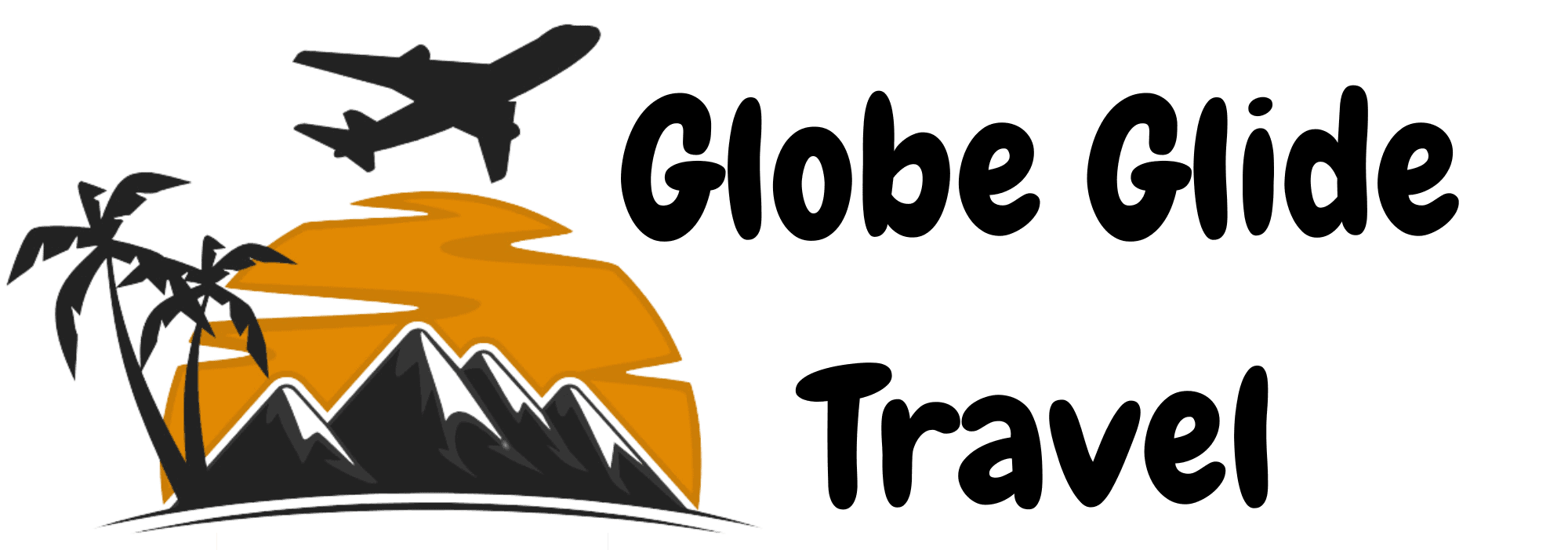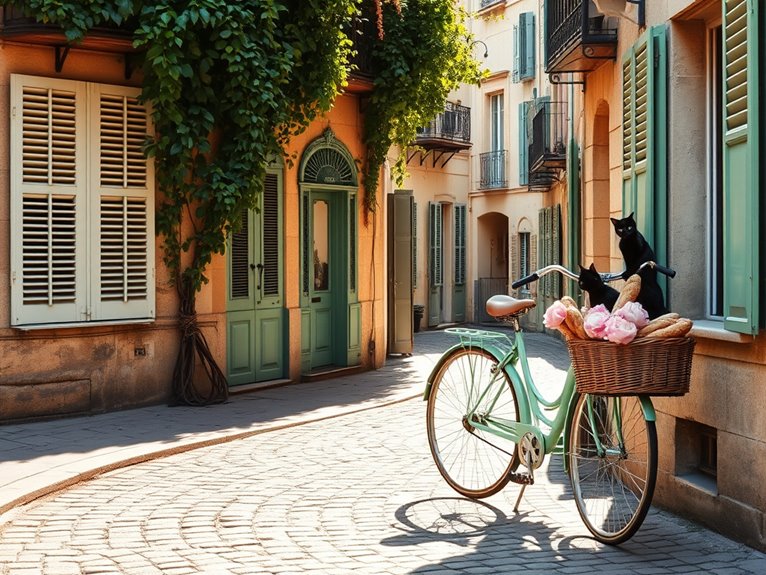
8 Instagram-Worthy Spots in Paris Beyond the Eiffel Tower
Looking for Instagram-worthy spots in Paris beyond the iconic tower? I've got eight hidden gems that'll make your feed pop! From the rainbow-colored houses of Rue Crémieux to the secret Sacré-Cœur views at Square Marcel Bleustein Blanchet, these spots are photographer favorites. Don't miss the vintage passages of the 2nd arrondissement, Le Consulat Café, the quirky Sinking House, Au Vieux Paris D'arcole's pink façade, Villa Léandre's English houses, and Saint-Étienne-du-Mont's famous steps. Let's explore each location's perfect photo angles and best times to visit.
Rue Crémieux: The Most Colorful Street in Paris
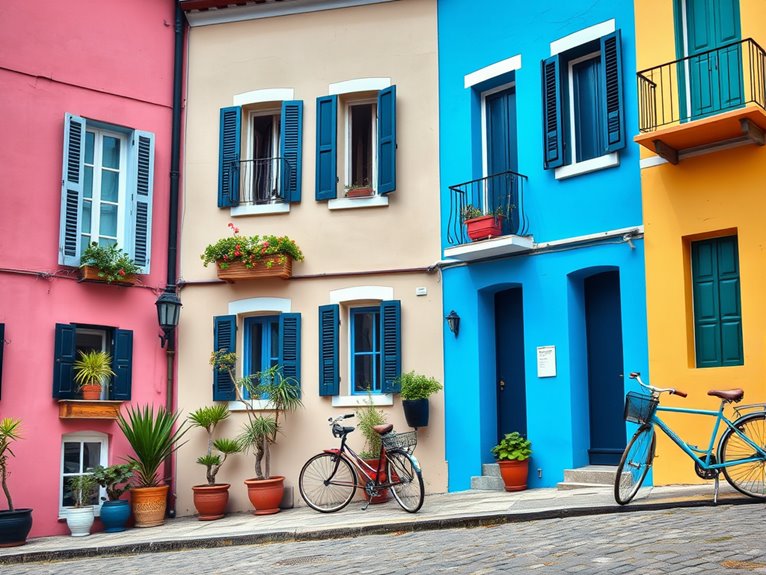
Instagram-Worthy Spots in Paris: Rue Crémieux
——————————————-
Tucked away in the 12th arrondissement, Rue Crémieux stands as Paris's most vibrantly colored street, offering a delightful departure from the city's typical Haussmann architecture. This pedestrian-only lane stretches for 144 meters, lined with pastel-painted houses in shades of pink, blue, yellow, and lavender, creating a whimsical backdrop that has become increasingly popular among photographers and social media enthusiasts.
What makes Rue Crémieux particularly special is its intimate village-like atmosphere, reminiscent of London's Notting Hill or Copenhagen's Nyhavn, yet distinctly Parisian in its charm. The street's relatively recent rise to Instagram fame has transformed it from a quiet residential haven into one of the city's most photographed locations, though it still maintains its authentic character through careful preservation and resident involvement.
Quick Facts:
- Best visiting hours: 9:00 AM – 6:00 PM (residents prefer no visitors after dark)
- Peak photography times: Early morning (7:00-9:00 AM) for best light
- Location: Between Rue de Lyon and Rue de Bercy, 12th arrondissement
- Nearest Metro: Gare de Lyon (Lines 1, 14, RER A and D)
- Photography restrictions: Respect resident privacy, no commercial shoots without permits
- Best season: Spring and summer for excellent natural lighting
The Street's Highlights:
No. 23 stands out with its distinctive pink façade and blue shutters, often serving as the street's most photographed house. The symmetrical placement of its windows and the climbing vines create perfect framing opportunities for photographers. Local residents have maintained the original 19th-century architectural details while embracing the street's colorful character.
The famous blue house at No. 12 features white trim and red flower boxes, creating a striking contrast that attracts particular attention. Insider tip: This house appears most vibrant in morning light, between 8:00-10:00 AM, when the sun hits it at an angle that makes the colors pop without harsh shadows.
Pro Tips:
Visit on weekdays rather than weekends to avoid crowds, and always be mindful that this is primarily a residential street. The best photographs can be achieved by using a wide-angle lens to capture entire façades, while a 50mm lens works well for detail shots of doors and windows. Consider visiting during or after light rain, when the wet cobblestones create beautiful reflections of the colored houses.
Practical Advice:
Remember that Rue Crémieux is home to actual residents who have become increasingly protective of their privacy. Photography should be limited to building exteriors, and voices should be kept down. Some residents have installed "No Photography" signs that should be respected. For the most respectful experience, limit visits to 10-15 minutes and avoid setting up elaborate photography equipment. The street has recently implemented weekend closures to tourists, so check local announcements before planning your visit.
Square Marcel Bleustein Blanchet's Secret Sacré-Cœur Views
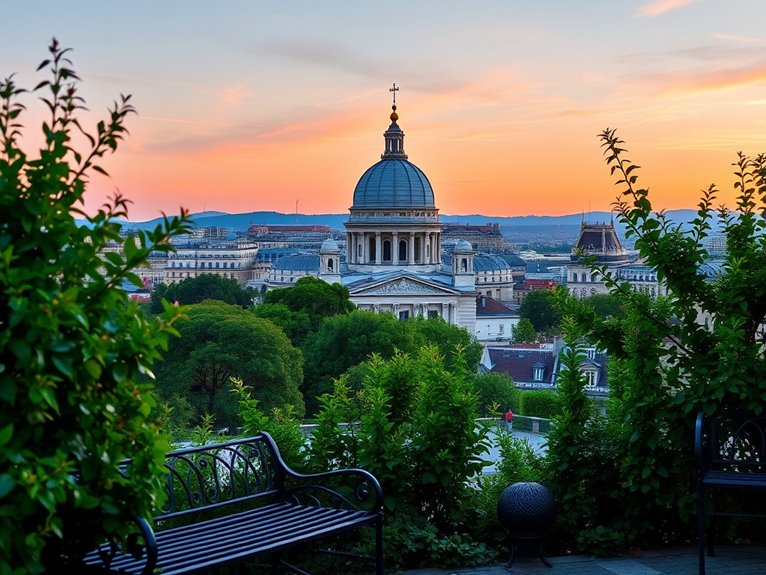
Tucked away behind the iconic Sacré-Cœur Basilica lies one of Paris's best-kept secrets: Square Marcel Bleustein Blanchet. This hidden gem offers photographers and Instagram enthusiasts an unparalleled vantage point of both the majestic basilica and sweeping views of Paris, without the overwhelming crowds that gather on the basilica's main steps.
Originally known as Square Nadar, this carefully landscaped garden space underwent renovation in 2004 and was renamed to honor a prominent French advertising pioneer. The square's elevated position and thoughtfully designed terraces create perfect framing opportunities for the Sacré-Cœur, while its relative obscurity means visitors can take their time setting up shots and enjoying the panoramic views.
Quick Facts:
- Best visiting hours: 7:00 AM – 8:30 PM (summer), 7:00 AM – 6:00 PM (winter)
- Cost: Free
- Best photography times: Sunrise and golden hour
- Crowd levels: Low to moderate
- Photography gear allowed: All cameras and tripods permitted
- Access: Steps and slopes (not wheelchair accessible)
- Nearest Metro: Anvers (Line 2)
The Square's Unique Features:
The square consists of three main terraces, each offering distinct perspectives of Sacré-Cœur. The lowest level features manicured French gardens and benches, perfect for relaxed shooting sessions. The middle terrace provides the most popular photo angles, with carefully planned gaps in the vegetation that frame the basilica. The uppermost level connects directly to Rue du Chevalier de la Barre, offering the closest views of the basilica's intricate architecture.
Location and Access:
Find the square by walking around the right side of Sacré-Cœur Basilica, following Rue du Chevalier de la Barre. The entrance is marked by an ornate gate and informational plaque. While the basilica draws thousands of visitors daily, this adjacent square rarely sees more than a dozen people at once.
Pro Tips:
For the most dramatic shots, arrive just before sunrise when the morning light bathes the white stone of Sacré-Cœur in warm golden hues. The square's western exposure makes it ideal for afternoon and sunset photography, with the sun positioning perfectly behind the basilica. Consider bringing a wide-angle lens to capture both the architectural details and the expansive city views in a single frame.
Practical Advice:
While the square is generally safe, it's relatively isolated compared to the main basilica area. Visit with a companion during early morning or late evening shoots, and keep equipment close. The surrounding Montmartre neighborhood offers numerous cafés and restaurants, making it easy to combine a photo session with a meal or coffee break. Remember that the terrain involves several flights of stairs, so wear comfortable shoes and pack light.
The Hidden Passages of the 2nd Arrondissement
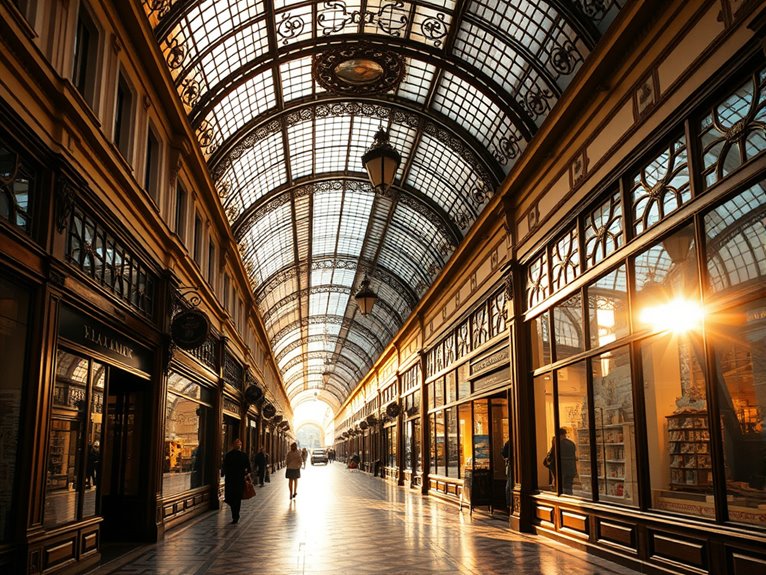
Step back in time through Paris's enchanting covered passages, architectural gems dating back to the 18th and 19th centuries. These elegant glass-roofed arcades in the 2nd arrondissement once served as shopping galleries for the Parisian elite, featuring elaborate mosaic floors, ornate ironwork, and magnificent skylights that create an ethereal atmosphere perfect for photography.
Today, these hidden passages offer a respite from Paris's busy streets, housing vintage bookshops, antique dealers, art galleries, and charming cafés. While tourists flock to the Champs-Élysées, these lesser-known architectural treasures provide authentic glimpses into historical Paris while offering countless Instagram-worthy photo opportunities.
Quick Facts:
- Best visiting hours: 10:00 AM – 7:00 PM (individual shop hours vary)
- Most photogenic times: Late morning when natural light streams through skylights
- Free admission to all passages
- Most shops closed on Sundays
- Photography allowed, but tripods generally prohibited
- Climate-controlled spaces, perfect for rainy days
Passage des Panoramas
The oldest covered passage in Paris (1799), Passage des Panoramas captivates with its vintage stamp shops, traditional restaurants, and historic décor. Located at 11 Boulevard Montmartre, this passage pioneered gas lighting in Paris. Don't miss Stern graveur, operating since 1834, showcasing traditional engraving techniques. Insider tip: Visit Restaurant Racines, hidden in a corner, for exceptional natural wines and seasonal French cuisine.
Galerie Vivienne
The most elegant of all passages, Galerie Vivienne boasts stunning neo-classical architecture, intricate mosaic floors, and rotunda with glass dome. Found at 4 Rue des Petits-Champs, it houses luxury boutiques and the famous Legrand Filles et Fils wine shop. Insider tip: The light is most magical for photos between 2-4 PM when sunbeams create patterns through the glass ceiling.
Passage des Princes
Recently restored to its former glory, this passage at 5 Boulevard des Italiens specializes in toys and collectibles. Its modern renovation maintains historical charm while offering contemporary shopping experiences. Insider tip: Visit during December to see spectacular Christmas decorations and unique vintage toy displays.
Pro Tips:
Create a strategic route linking multiple passages for the best experience. Start at Passage des Panoramas, continue to Galerie Vivienne, and end at Passage des Princes. Visit during weekday mornings to avoid crowds and capture photos without people. Consider bringing a wide-angle lens to capture the stunning architectural details and a fast lens for low-light conditions inside the passages.
Practical Advice:
While exploring the passages, remember these are active shopping areas with residents and workers. Respect shop owners when taking photos, and purchase something small from the unique boutiques to support these historical venues. Many shops still observe traditional French lunch hours (roughly 1-3 PM), so plan accordingly. Carry a detailed map as entrances can be subtle and easy to miss from the street.
Le Consulat Café in Montmartre

Perched on the charming corner of rue Norvins and rue des Saules in Montmartre, Le Consulat Café stands as one of Paris's most photographed cafés. This historic establishment, with its distinctive red awning and classic French bistro facade, has become an iconic symbol of Parisian café culture and a must-visit destination for photographers and Instagram enthusiasts alike.
Dating back to the late 19th century, Le Consulat has served as a gathering spot for artists, writers, and locals for generations. Its prime location in the heart of artistic Montmartre, combined with its perfectly preserved vintage exterior and authentic Parisian atmosphere, makes it an irresistible subject for both casual snapshots and professional photography sessions.
Quick Facts:
- Best Photo Times: Early morning (7-9 AM) or during golden hour (1 hour before sunset)
- Price Range: €4-20 for drinks, €15-25 for main dishes
- Peak Tourist Hours: 11 AM – 4 PM
- Reservation Status: No reservations accepted
- Photography Rules: Exterior photos welcome; interior photos at staff discretion
- Accessibility: Limited seating, steep hillside location
- Payment Methods: Cash and major credit cards accepted
Location and Experience:
Le Consulat is situated at 18 Rue Norvins, 75018 Paris, just steps from the Sacré-Cœur Basilica. The café's exterior features classic French architecture, with signature red awnings, vintage signage, and abundant flower boxes during spring and summer. While the interior offers traditional French bistro fare, it's the exterior that draws countless photographers. The café's position on a sloping cobblestone street creates perfect leading lines for compositions, while the surrounding Montmartre architecture provides an authentic Parisian backdrop.
Insider Tip: The café's corner location actually offers three distinct photo opportunities – the front facade, the side view with climbing vines, and a unique angle capturing both the café and the distant Sacré-Cœur in one frame. Most visitors only photograph the front, missing these additional perspectives.
Pro Tips:
For the best photography experience, arrive before 8 AM when the streets are nearly empty and the morning light creates a magical atmosphere. The café's awnings are typically rolled out around 9 AM, so early arrivals can capture both bare and decorated versions of the facade. Consider visiting on weekdays rather than weekends, as local residents often create organic photo opportunities while going about their daily routines, adding authenticity to your shots.
Practical Advice:
While Le Consulat is primarily known as a photo destination, consider actually dining at the café to support the establishment and experience authentic French café culture. The best strategy is to photograph the exterior during early morning hours, then return later for coffee or lunch. Remember that the surrounding area is particularly steep, so wear comfortable walking shoes and plan your route in advance, as the narrow Montmartre streets can be confusing to navigate.
Sinking House of Montmartre
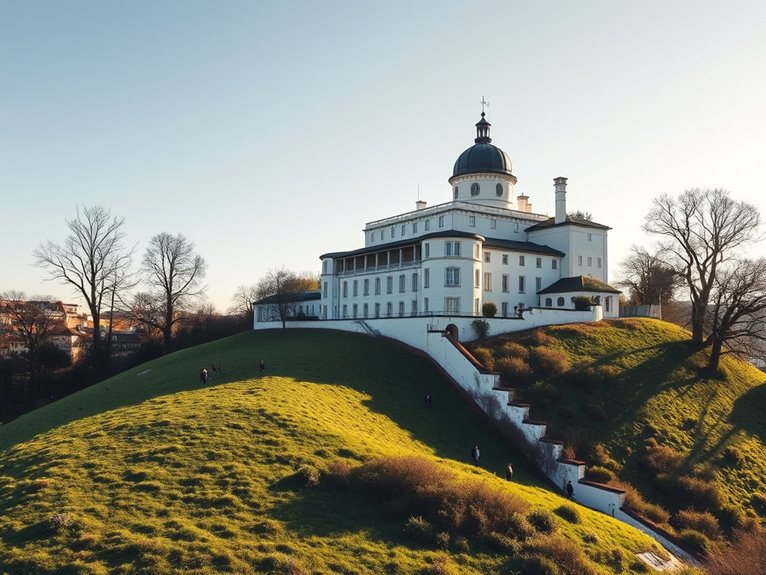
The iconic "Sinking House" of Montmartre isn't actually sinking at all – it's one of Paris's most ingenious optical illusions that has captured the imagination of photographers and social media enthusiasts worldwide. Perched near the famous Sacré-Cœur Basilica, this seemingly tilted building has become a must-capture shot for visitors seeking unique perspectives of the City of Light.
What makes this spot particularly fascinating is how it challenges our perception of reality. The building appears to be dramatically tilted due to a clever trick of perspective when viewed from the Sacré-Cœur's grassy hill. In reality, it's the hill that's at an angle while the building stands perfectly straight – a revelation that adds to the location's charm and demonstrates how photography can transform ordinary architecture into extraordinary art.
Quick Facts:
- Best visiting hours: Early morning (7-9 AM) or late afternoon (4-6 PM) for ideal lighting
- Cost: Free
- Photography equipment needed: Any camera or smartphone
- Location: Steps of Sacré-Cœur Basilica, Montmartre
- Best season: Year-round, though spring and fall offer clearest skies
- Crowd levels: Moderate to high during midday
- Time needed: 15-30 minutes for perfect shot
The Perfect Shot Setup
The ideal position to capture the Sinking House is from the grassy steps on the right side of Sacré-Cœur Basilica. To achieve the illusion, position your camera at a slight tilt, aligning the steps horizontally in your frame. This will make the building appear to be sinking into the hill, while everything else looks dramatically askew. The exact spot is about halfway up the stairs, offering the best angle for the optical illusion.
Pro Tips:
The key to nailing this shot lies in the details of your camera positioning. Tilt your camera approximately 45 degrees to align with the hill's slope, then straighten the steps in your viewfinder until they appear horizontal. For maximum impact, include both the building and some of the steps in your composition. Experiment with different angles and heights to find your preferred perspective. Many photographers miss the opportunity to capture reflection shots on rainy days, when the wet steps can create mirror-like surfaces.
Practical Advice:
Visit during off-peak hours to avoid other photographers and tourists in your shot. Be mindful of your surroundings while setting up your shot, as the steps can be crowded. Bring a small cloth to wipe the steps if they're wet or dirty, as you might need to kneel or sit to get the perfect angle. Consider visiting multiple times throughout your stay in Paris, as different lighting conditions can dramatically affect the final image. Remember that the area around Sacré-Cœur is a popular tourist destination, so keep your belongings secure while focusing on photography.
Pink Façade of Au Vieux Paris D'arcole
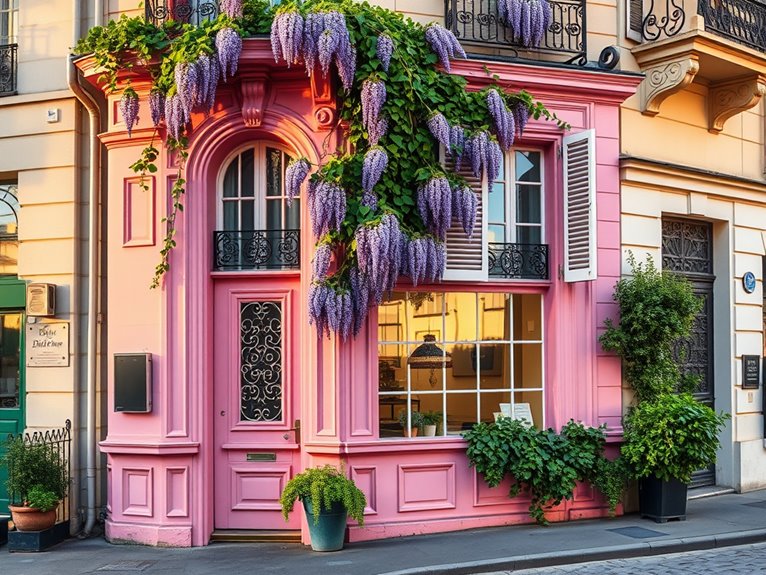
Nestled in the heart of Paris's 4th arrondissement, the pink-hued façade of Au Vieux Paris D'arcole stands as one of the city's most photographed hidden gems. This charming restaurant, with its distinctive pink exterior and climbing wisteria, has become a social media sensation, drawing photographers and influencers from around the world seeking to capture its romantic Parisian essence.
The building's fame extends beyond its stunning appearance, as it represents one of the oldest structures in Paris, dating back to the 16th century. Located steps away from Notre-Dame Cathedral, this historic establishment combines authentic Parisian architecture with a beautifully curated aesthetic that exemplifies the city's timeless charm and Instagram-worthy appeal.
Quick Facts:
- Best Photography Times: Early morning (7-9 AM) or during golden hour
- Peak Blooming Season: April-May (wisteria)
- Restaurant Hours: 12 PM – 11 PM (closed Mondays)
- Photography Policy: Exterior photos permitted; interior requires permission
- Address: 24 Rue Chanoinesse, 75004 Paris
- Nearest Metro: Cité (Line 4)
The iconic pink façade features intricate architectural details enhanced by the vibrant climbing wisteria, which transforms the building's appearance throughout the seasons. The restaurant occupies a prime location on Rue Chanoinesse, a picturesque cobblestone street that adds to the overall romantic atmosphere. While the exterior photos are free, dining at the restaurant offers traditional French cuisine with main courses ranging from €25-45.
Insider Tip: The building's pink color appears most vibrant during overcast days, creating perfect conditions for photography without harsh shadows. Additionally, the lesser-known northern side of the building features unique architectural details often missed by casual visitors.
Pro Tips:
The ideal time for photographing the façade without crowds is during weekday mornings, particularly Tuesday through Thursday. Position yourself slightly diagonal to the building to capture both the façade and the charming street perspective. During wisteria season, visit multiple times throughout the day, as the changing light creates distinctly different moods in your photographs.
Practical Advice:
While capturing photos of the exterior, respect the restaurant's business operations and local residents. The area can become crowded quickly, so arrive early and be prepared to wait for the perfect shot. Consider combining your visit with other nearby attractions, such as Notre-Dame Cathedral or the Shakespeare and Company bookstore, to maximize your time in this historic district.
Villa Léandre's English-Style Houses
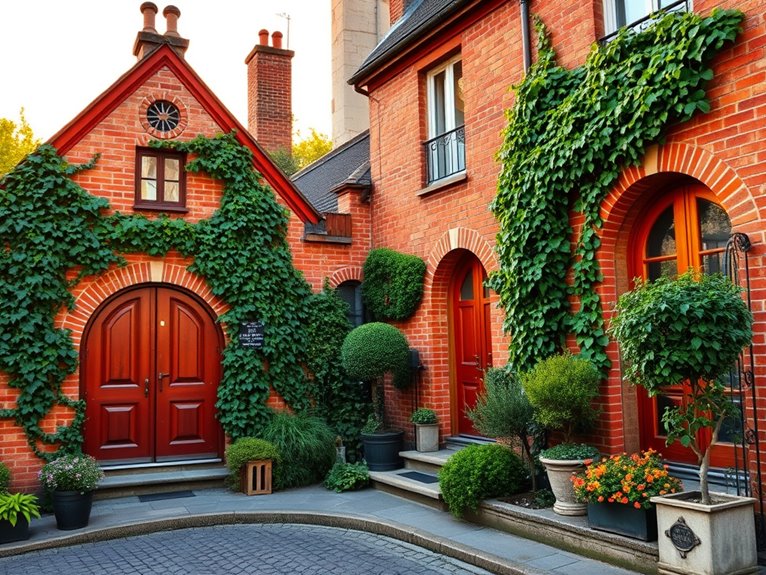
Tucked away in the artistic Montmartre district, Villa Léandre stands as a charming anomaly in Paris's architectural landscape. This private cobblestone street, lined with distinctive Anglo-Norman style houses, offers visitors a surprising escape from typical Parisian aesthetics, transporting them to what feels like a quaint London neighborhood.
Built in the 1920s, these elegant townhouses represent a unique architectural experiment that has become one of Paris's most photogenic hidden gems. Each house features distinctive red brick facades, decorative shutters, and meticulously maintained front gardens, creating a stark contrast to the surrounding Haussmann-style buildings that dominate the city.
Quick Facts:
- Best visiting hours: 8:00 AM – 10:00 AM for ideal lighting and minimal crowds
- Photography permitted: Yes (exterior only)
- Location: 75018 Paris, between rue Junot and avenue Junot
- Nearest Metro: Lamarck-Caulaincourt (Line 12)
- Best season: Spring and early fall for blooming gardens
- Access: Public street, but respect private property
- Photography tips: Wide-angle lens recommended
The Houses:
Villa Léandre consists of 17 private residences, each maintaining its original 1920s charm. House number 15 is particularly famous for its whimsical "Rue Léandre" street sign written in an English style, making it a favorite Instagram spot. The architectural details include bay windows, distinctive chimneys, and Art Deco elements that reflect the period's aesthetic sensibilities.
Insider Tip: Look for house number 10, which features a carved stone face above its doorway – a detail often missed by casual observers.
The Street:
The cobblestone pathway leading through Villa Léandre creates perfect leading lines for photography. The street's curve provides multiple vantage points for capturing the houses' facades. Each season brings different photographic opportunities, from spring blooms to autumn foliage against the red brick backgrounds.
Pro Tips:
Early morning visits offer the best lighting conditions, with gentle shadows highlighting the architectural details. Weekday mornings tend to be quieter than weekends, allowing for unobstructed photos. Consider visiting during golden hour for warm, atmospheric shots that emphasize the red brick facades and garden features.
Practical Advice:
Remember that Villa Léandre is a residential area, so maintain respectful distance from private properties and keep noise levels down. Photography should be limited to external shots, and tripods may draw attention from residents. Combine your visit with exploration of nearby Montmartre attractions, such as Place Dalida or the Sacré-Cœur, to maximize your time in the area.
Saint-Étienne-du-Mont Church Steps
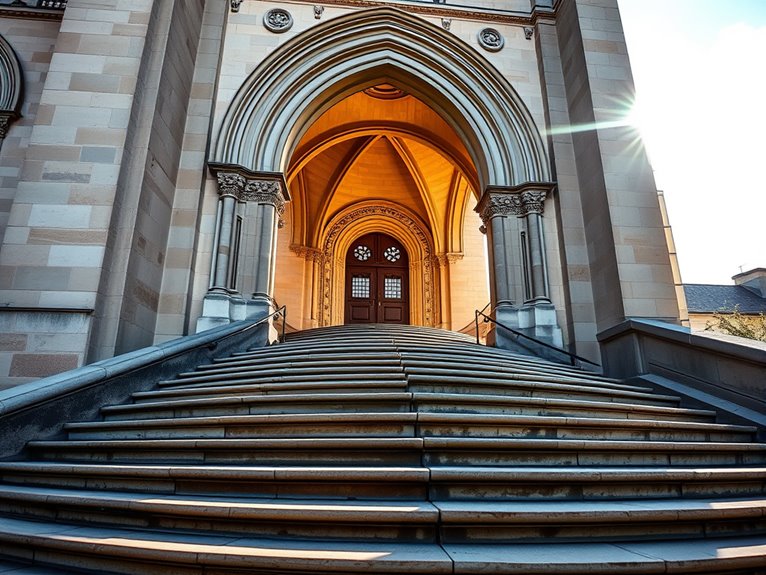
The iconic steps of Saint-Étienne-du-Mont Church gained worldwide fame after being featured in the movie "Midnight in Paris," where Owen Wilson's character waited for his magical midnight journey. These historic limestone steps, dating back to the 16th century, offer not just a cinematic connection but also a superb vantage point for capturing the essence of Paris's Latin Quarter.
Nestled in the heart of the 5th arrondissement, these steps provide photographers with a unique blend of architectural beauty and cultural significance. The stunning fusion of Gothic and Renaissance styles creates dramatic shadows and angles throughout the day, while the adjacent church's elaborate facade serves as an impressive backdrop for both professional and amateur photographers.
Quick Facts:
- Best visiting times: Early morning (7-9 AM) or late afternoon (4-6 PM) for ideal lighting
- Photography permitted: Yes, exterior only
- Access: Free
- Nearest Metro: Cardinal Lemoine (Line 10) or Luxembourg (RER B)
- Best season: Spring and Fall for moderate crowds and pleasant weather
- Photography tips: Wide-angle lens recommended for capturing full facade
The Steps Experience:
The church steps consist of a curved staircase leading to the main entrance, featuring intricate stone balustrades and worn limestone treads that speak to centuries of use. Located at 2 Rue Valette, the steps offer a superb composition point for photographers, with the possibility to capture both upward and downward angles. The surrounding area's medieval architecture provides additional atmospheric elements for your shots.
Pro Tips:
For the most atmospheric photos, visit during the blue hour (just before sunrise or after sunset) when the church's warm lighting contrasts beautifully with the natural light. Consider using a tripod during these low-light conditions, though be mindful of other visitors. Rainy days can create stunning reflective surfaces on the worn limestone, offering unique photography opportunities rarely captured by typical tourists.
Practical Advice:
While the steps are publicly accessible, remember this is an active place of worship. Respectful behavior is essential, particularly during service times. Avoid blocking the entrance or steps for extended periods while taking photos. The area can get crowded with tour groups between 10 AM and 4 PM, so plan your visit outside these hours. Additionally, bring a versatile lens that can capture both wide-angle architectural shots and detailed close-ups of the ornate stonework.
